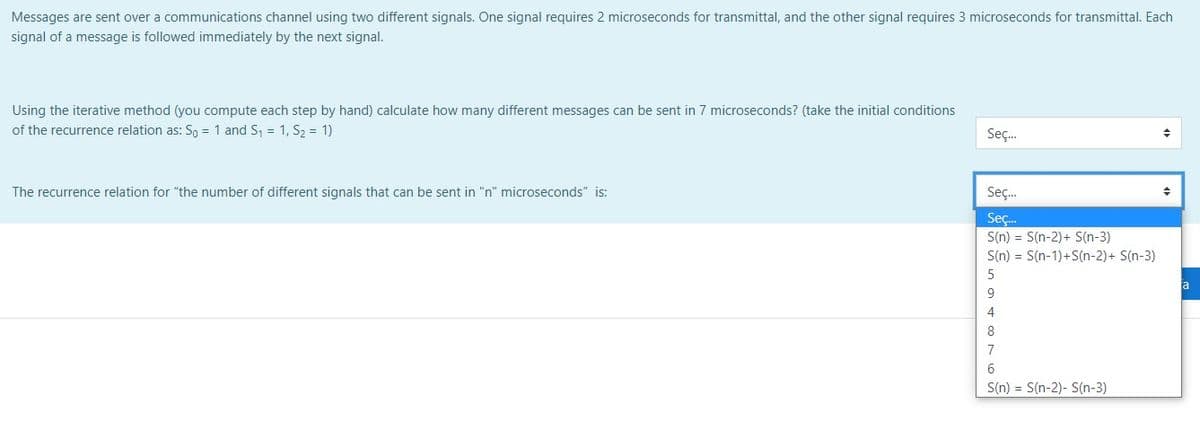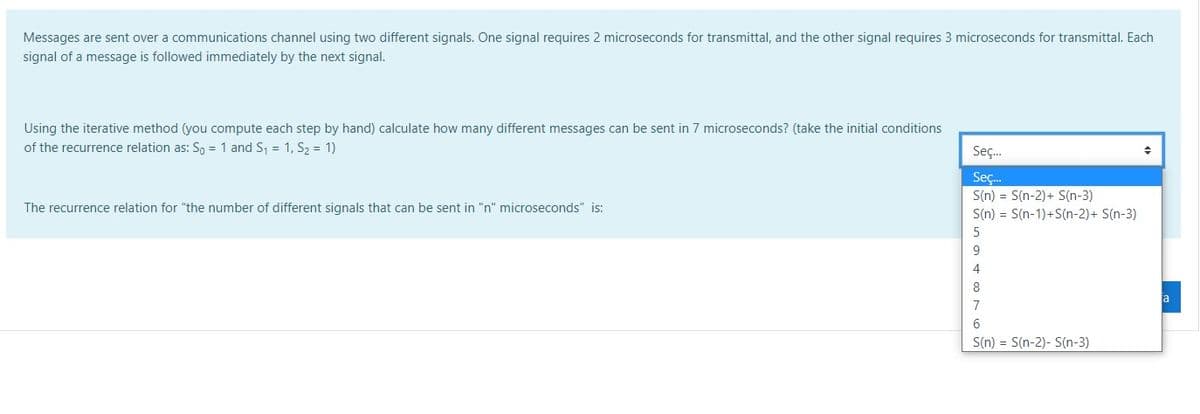Messages are sent over a communications channel using two different signals. One signal requires 2 microseconds for transmittal, and the other signal requires 3 microseconds for transmittal. Each signal of a message is followed immediately by the next signal. Using the iterative method (you compute each step by hand) calculate how many different messages can be sent in 7 microseconds? (take the initial conditions of the recurrence relation as: So = 1 and S, = 1, S2 = 1) Seç. The recurrence relation for "the number of different signals that can be sent in "n" microseconds" is: Seç. Sec.
Messages are sent over a communications channel using two different signals. One signal requires 2 microseconds for transmittal, and the other signal requires 3 microseconds for transmittal. Each signal of a message is followed immediately by the next signal. Using the iterative method (you compute each step by hand) calculate how many different messages can be sent in 7 microseconds? (take the initial conditions of the recurrence relation as: So = 1 and S, = 1, S2 = 1) Seç. The recurrence relation for "the number of different signals that can be sent in "n" microseconds" is: Seç. Sec.
Linear Algebra: A Modern Introduction
4th Edition
ISBN:9781285463247
Author:David Poole
Publisher:David Poole
Chapter4: Eigenvalues And Eigenvectors
Section4.6: Applications And The Perron-frobenius Theorem
Problem 56EQ
Related questions
Question

Transcribed Image Text:Messages are sent over a communications channel using two different signals. One signal requires 2 microseconds for transmittal, and the other signal requires 3 microseconds for transmittal. Each
signal of a message is followed immediately by the next signal.
Using the iterative method (you compute each step by hand) calculate how many different messages can be sent in 7 microseconds? (take the initial conditions
of the recurrence relation as: So = 1 and S = 1, S2 = 1)
Seç.
The recurrence relation for "the number of different signals that can be sent in "n" microseconds" is:
Seç.
Seç.
S(n) = S(n-2)+ S(n-3)
S(n) = S(n-1)+S(n-2)+ S(n-3)
a
4
8
7
S(n) = S(n-2)- S(n-3)

Transcribed Image Text:Messages are sent over a communications channel using two different signals. One signal requires 2 microseconds for transmittal, and the other signal requires 3 microseconds for transmittal. Each
signal of a message is followed immediately by the next signal.
Using the iterative method (you compute each step by hand) calculate how many different messages can be sent in 7 microseconds? (take the initial conditions
of the recurrence relation as: Sn = 1 and S, = 1, S, = 1)
Seç.
Seç.
S(n) = S(n-2)+ S(n-3)
The recurrence relation for "the number of different signals that can be sent in "n" microseconds" is:
S(n) = S(n-1)+S(n-2)+ S(n-3)
5
4
8
a
7
6.
S(n) = S(n-2)- S(n-3)
Expert Solution
This question has been solved!
Explore an expertly crafted, step-by-step solution for a thorough understanding of key concepts.
Step by step
Solved in 2 steps with 2 images

Knowledge Booster
Learn more about
Need a deep-dive on the concept behind this application? Look no further. Learn more about this topic, calculus and related others by exploring similar questions and additional content below.Recommended textbooks for you

Linear Algebra: A Modern Introduction
Algebra
ISBN:
9781285463247
Author:
David Poole
Publisher:
Cengage Learning

Algebra & Trigonometry with Analytic Geometry
Algebra
ISBN:
9781133382119
Author:
Swokowski
Publisher:
Cengage

Linear Algebra: A Modern Introduction
Algebra
ISBN:
9781285463247
Author:
David Poole
Publisher:
Cengage Learning

Algebra & Trigonometry with Analytic Geometry
Algebra
ISBN:
9781133382119
Author:
Swokowski
Publisher:
Cengage